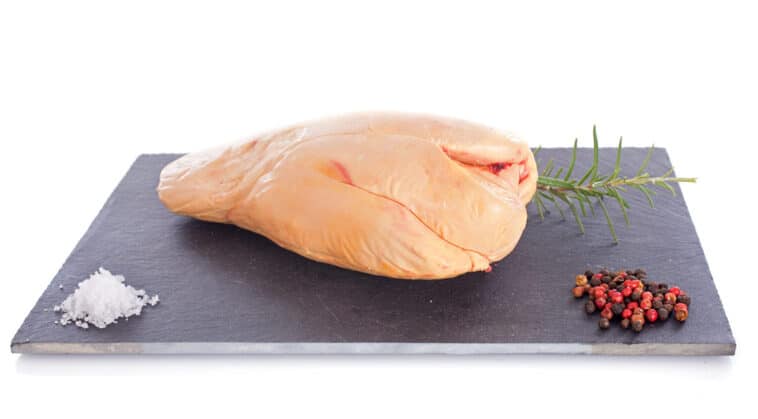Foie gras, which means fatty liver, is a typical dish from the southwest region of France, made with goose or duck liver with lipid hypertrophy. To make the liver tasty and juicy, the animal is fed to exhaustion.
This noble, luxurious and controversial dish can be served as a pâté, cooked or sliced raw, either as a main dish or as a side dish. Despite being a very caloric and fatty food, it is rich in nutrients such as iron, copper, vitamin A, and vitamin B12. In addition, it is anti-inflammatory.
History Of The Foie Gras
The history of this dish begins in the Egyptian civilization, around the 25th century BC. At that time, the practice of fattening migratory birds already existed since the Egyptians had discovered that the birds’ liver tasted better when using this technique.
There are even historical records of drawings made by the Egyptian civilization on the tomb of a royal official, Mereruca, in the necropolis of Sacara, depicting scenes in which slaves forced birds to swallow food.
Over time this practice became popular and spread throughout the Mediterranean basin, passing through the Greeks and then the Romans. In addition, it was already common to feed birds with figs in ancient Rome. But the foie gras ceased to be prepared after the fall of the Roman Empire.

Post Classic Period
Geese were left out of European gastronomy after the fall of the Roman Empire, temporarily.
Records indicate that Jews learned and preserved the recipe after Rome colonized Israel, taking the tradition with them during migration. And since the Jews always had the practice of respecting Jewish law, they didn’t eat all kinds of meat, especially pork.
In addition, they could neither use butter, because it is a type of dairy product nor lard to make culinary preparations. Then they realized that the geese produced fat when they were very well fed.
It was then that the Jews began to use the fat and liver of overfed geese for preparing meals, both because it was a species considered “pure” for consumption and because it had a light and delicate flavor.
However, the religious leaders of the time had reservations about the mistreatment of animals and the consumption of liver. This mistrust caused the practice to fall into disuse in the 19th century. But some non-Jewish cooks of the time preserved the tradition, which continues to this day.
Foie Gras Today
Nowadays, foie gras is a noble dish, served mainly on special occasions such as end-of-year parties, holidays, and birthdays, due to its high value.
There are several ways to present it, of which the most widespread is the pate. But some people prefer to taste it in its most natural form, that is, freshly taken from the goose or duck. It can also be served cooked or sliced.
Manufacturing Method
In the first stage, the ducks or geese are fed with corn and are confined for about 100 days to facilitate the process of weight gain. In confinement, artificial lighting is used to keep the animals awake so that they eat more often.
The geese are fed twice a day for about four weeks. When they do not eat voluntarily for some reason, the breeders inject the food through a pipe that is placed into the esophagus.
But it is important to mention that this process generates discomfort for the animals, whose body is hyperstimulated, leaving them agitated and energetic. Thus, they end up growing about twelve times when compared to their original size.
The fat in the animal’s body can make up to approximately 60% of its weight, increasing the amount of visceral fat around the animal’s liver.
After approximately four months, the animal is analyzed and, if everything conforms, it is slaughtered. The liver, which has a semi-firm, soft consistency and is pale pink, is removed.
Foie Gras: A Controversial Dish
Despite the fame of the dish, the way the liver is produced generates a lot of controversies worldwide. So much so that the production of foie gras is banned in over twenty countries, others even prohibit the importation of the delicacy, after pressure from animal rights bodies.
Some people consider the way geese and ducks are forced to feed to be cruel. This process is known by the French word “gavage”, which means “force-feeding”. They claim that inserting the tube can cause serious injury to the neck, causing inflammation and infectious diseases in the animals.
The farmers claim that the animals do not suffer or feel discomfort as they do not choke. They also claim that ducks and geese are already accustomed to feeding with large quantities of food to travel long distances during migration.

Proclamation On The Abolition Of Gavage
Animal rights protectors in France achieved in the year 2003 the publication of the Proclamation for the Abolition of Gavage, which document was based on already existing laws protecting animal rights, proving the illegal practice of force-feeding.
But as these laws are not very objective, it was only stipulated by the Council of the European Union that producers could continue with the practice, as long as they followed recommendations that ensured the animals did not suffer unnecessarily.
Therefore, producers have become more careful in the process.
However, they did not give up and wrote a report in which they refute the disadvantages of force-feeding advocated by opponents of the practice. But still many countries do not accept it.
For example, there are the countries Argentina, six provinces of Austria, Germany, Denmark, Finland, Ireland, Israel, Luxembourg, Norway, Netherlands, Poland, United Kingdom, Czech Republic, Switzerland, and Sweden.
Gavage in Brasil
The São Paulo city government had banned the production of foie gras in 2015, but shortly afterward the São Paulo Court of Justice allowed it again after the National Restaurant Association obtained an injunction revoking the decision.
A new trial is awaiting the decision of the TJ-SP.
Tradition Foie Gras Recipe
To prepare foie gras is quite simple, you just need duck or goose liver and some special seasonings.
Initially, open and clean the liver, removing blood and vein residues with a knife, and if necessary use a clean, dry cloth. Remember that its consistency will normally be soft.
Mix all the spices and wrap them around the liver so that it is completely covered. Wrap it in cling film and place it in the fridge for about six hours.
Then place in an oven-proof dish, add a little brandy, squeeze the liver so that it is completely inside the dish. Place in the oven in a bain-marie for approximately one and a half hours.
After baking, remove from oven, let it cool, and put it back in the refrigerator for at least a whole day. Remove the layer of fat that will accumulate on top, and serve. You can serve it sliced, or as a pâté for bread and toast.
Curiosities
- To accompany a good foie gras, the ideal is to use long Bengal-style bread, dry white wine, liqueurs, salads, fresh fruit jelly (especially fig jelly). In addition, it should be consumed in small quantities.
- In France, the sale of foie gras is defined by law, from the noblest form to the least noble. The noble form, foie gras entier (or whole foie gras) is sold as a whole piece of liver. There is the common foie gras, which is made from pieces of liver. And the less noble form, the bloc de foie gras, which is the cooked block, is made of 98% foie gras.
- Foie gras is present in VGE Soup, one of the most famous dishes of the renowned chef Paul Bocuse.
- Duck liver has a more buttery flavor, while goose liver has a milder flavor and is the most expensive.




GIPHY App Key not set. Please check settings